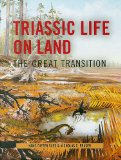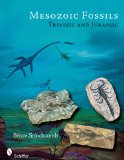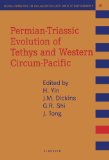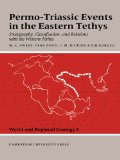Triassic
- A close-up view of the Permian-Triassic boundary based on expanded organic carbon isotope records from Norway (Trondelag and Finnmark Platform)

- A comparison of the biological, geological events and environmental backgrounds between the Neoproterozoic-Cambrian and Permian-Triassic transitions

- A Late Triassic lake system in East Greenland: facies, depositional cycles and palaeoclimate

- A new chronology for the end-Triassic mass extinction

- A new chronology for the late Triassic to early Jurassic

- Albertiana - the printed/web newsletter of the Subcommission on Triassic Stratigraphy
- All about Upper Triassic
- Anisian carbonate ramp system of Central Europe (Peri-Tethys Basin): sequences and reservoir characteristics

- Anomalies in global carbon cycling and extinction at the Triassic/Jurassic boundary: evidence from a marine C-isotope record

- Bedding rhythms in Triassic basins of the Southern Alps

- Bio- and chemostratigraphic assessment of carbon isotope records across the Triassic–Jurassic boundary at Csővár quarry (Hungary) and Kendlbachgraben (Austria) and implications for global correlations

- Carbon isotope anomaly and other geochemical changes at the Triassic/Jurassic boundary from a marine section in Hungary

- Climate change at the Triassic/Jurassic boundary in the northwestern Tethyan realm, inferred from sections in the Tatra Mountains (Slovakia)

- Continental Triassic-Jurassic boundary in central Pangea: Recent progress and preliminary report of an Ir anomaly

- Controlling factors of two Middle Triassic carbonate platforms: Latemar and Rosengarten (Dolomites, Northern Italy)

- Cyclo-, Magneto-, and Bio-Stratigraphic Constraints on the Duration of the CAMP Event and its Relationship to the Triassic-Jurassic Boundary

- Dating the end-Triassic and Early Jurassic mass extinctions, correlative large igneous provinces, and isotopic events

- Diagenesis of Microbial Carbonates: A Case History from the Norian of the Italian Peninsula

- Diversity dynamics of the Triassic marine biota in the Western Caucasus (Russia) : A quantitative estimation and a comparison with the global patterns

- Dolomite formation in the shallow seas of the Alpine Triassic

- Early and Middle Triassic trends in diversity, evenness, and size of foraminifers on a carbonate platform in south China: implications for tempo and mode of biotic recovery from the end-Permian mass extinction

- Early Triassic Ammonoid Fossils In Nevada
- Ecological Signature of Lower Triassic Shell Beds of the Western Untied States

- Evolution of Early Triassic outer platform paleoenvironments in the Nanpanjiang Basin (South China) and their significance for the biotic recovery

- Facies and sedimentary environments of the Upper Scythian–Carnian succession from the Belanské Tatry Mts., Slovakia
- Foraminiferal survivors from the Permian-Triassic mass extinction in the Meishan section, South China

- Geological event sequences of the Permian-Triassic transition recorded in the microfacies in Meishan section

- Global boundary Stratotype Section and Point (GSSP) of the Ladinian Stage (Middle Triassic) at Bagolino (Southern Alps, Northern Italy) and its implications for the Triassic time scale

- IGCP 458 - Triassic-Jurassic boundary events
- IGCP 467 - Triassic time and correlations
- Impacts on Earth in the Late Triassic

- Implications of astronomical climate cycles to the chronology of the Triassic

- Integrated Anisian–Ladinian boundary chronology

- International Subcommission on Triassic Stratigraphy
- Late Early Triassic climate change: Insights from carbonate carbon isotopes, sedimentary evolution and ammonoid paleobiogeography

- Late Triassic-earliest Jurassic geomagnetic polarity reference sequence from cyclic continental sediments of the Newark rift basin

- Mailing List - friends_of_the_triassic
- Middle Triassic Ammonoid Fossils From Nevada
- Explosive eruption of coal and basalt and the end-Permian mass extinction
- International Symposium on the Global Stratotype of the Permian-Triassic Boundary and the Paleozoic-Mesozoic Events
- Late Triassic bivalves and brachiopods from southern Mendoza, Argentina

- Late Triassic timescale: Age and correlation of the Carnian–Norian boundary

- Magnetostratigraphic dating of the proposed Rhaetian GSSP at Steinbergkogel (Upper Triassic, Austria): Implications for the Late Triassic time scale

- Microfaunal Diversity And Diagenesis In The Muschelkalk Facies

- Middle Triassic evolution of the northern Peri-Tethys area as influenced by early opening of the Tethys Ocean

- Middle Triassic evolution of the Tatricum sedimentary basin: an attempt of sequence stratigraphy to the Wierchowa Unit in the Polish Tatra Mountains

- Milankovitch climate forcing in the tropics of Pangaea during the Late Triassic

- National Comission for Stratigraphy of Belgium - Subcommission Permian-Trias-Jurassic
- New trace fossil evidence for an early recovery signal in the aftermath of the end-Permian mass extinction

- New vistas on animal–plant–fungal interactions in the Permian–Triassic of Gondwana

- Norian-Rhaetian boundary in the light of micropaleontological data

- Oldest Triassic Platform Margin Reef From The Alpine-Carpathian Region (Aggtelek, Ne Hungary): Platform Evolution, Reefal Biota And Biostratigraphic Framework

- Paleontological Evidence for the Triassic Age of Rocks Dredged from the Northern Exmouth Plateau (Tethyan Foraminifers, Echinoderms, And Ostracodes)

- Petrology of carbonate beds from the stratotype of the Carnian (Stuores Wiesen section, Dolomites, Italy): the contribution of platform-derived microbialites

- Post-Hercynian Europe
- Report on the International Workshop for a Climatic, Biotic, and Tectonic, Pole-to-Pole Coring Transect of Triassic-Jurassic Pangea
- Smithian-Spathian boundary event: Evidence for global climatic change in the wake of the end-Permian biotic crisis

- Stratigraphy and palaeoenvironmental analysis of the Triassic-Jurassic transition in the western Southern Alps (Northern Italy)

- Stratigraphy of the Triassic Period
- Tethyan magnetostratigraphy from Pizzo Mondello (Sicily) and correlation to the Late Triassic Newark astrochronological polarity time scale

- Timing of the Early Triassic carbon cycle perturbations inferred from new U-Pb ages and ammonoid biochronozones

- Timing the end-Triassic mass extinction: First on land, then in the sea?

- Towards a better definition of the Middle Triassic magnetostratigraphy and biostratigraphy in the Tethyan realm

- Transient metazoan reefs in the aftermath of the end-Permian mass extinction

- Triasic
- Triassic
- Triassic
- Triassic
- Triassic-Jurassic Working group
- Triassic climates - State of the art and perspectives

- Triassic Period
- Triassic Period - Eons, Epochs, Etc.
- Triassic System
- Triassic Dinosaurs
- Triassic stratigraphy, facies and evolution of the Arabian shelf in the northern United Arab Emirates

- Triassic–Jurassic boundary events: problems, progress, possibilities

- Triassico
- Uppermost Triassic Limestone in the Karakaya Complex- Stratigraphic and Tectonic Significance

- Volcanism of the Central Atlantic Magmatic Province as a potential driving force in the end-Triassic mass extinction

Books about Triassic
| Permo-Triassic Events in the Eastern Tethys: Stratigraphy Classification and Relations with the Western Tethys Permian and Triassic rocks in the eastern Tethyan region form continuous marine sequences that record the waning phases of the Paleozoic and the early stages of the Mesozoic eras. This book describes and interprets these rocks, summarizing the distribution of major fossil groups in a way that will allow detailed comparison with strata of comparable age in the western Tethys and other parts of the world. The sixteen contributions by forty authors are the culmination of the five-year long International Geological Correlation Programme Project 203. The detailed information presented here is gathered from many areas in the eastern Tethyan region - from France to Australia - and will be of use in the evaluation of the major changes in the global marine biosphere known to have taken place at the end of the Paleozoic era. The stratigraphic record for this fascinating segment of Earth history is not widespread elsewhere in the world and is most continuous in the region covered by this book. |





